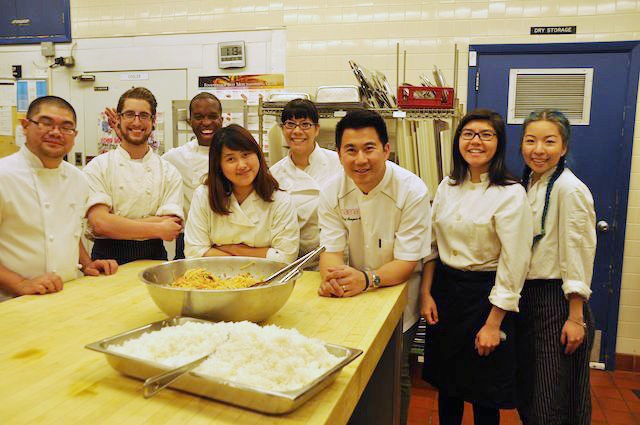Earlier this year, Vancouver Magazine Restaurant Awards (in its 27th year) crowned the popular Kitsilano Thai restaurant Maenam as the 2016 Restaurant of the Year.
And last month, McNair secondary’s Culinary Arts students were treated to a first-rate day of learning with Angus An, chef/owner of not only Maenam, but three other popular restaurants: Longtail Kitchen and Freebird Chicken Shack (both in New Westminster Quay) and Fat Mao Noodles (in Chinatown).
Each block had the opportunity to learn about Thai ingredients and cuisine and watch chef Angus demonstrate how to make Penang curry paste from scratch in his mortar and pestle.
After making the curry paste, he fried it in cracked coconut cream to flavour the curry, and cafeteria customers were treated to a lunch consisting of the fragrant Penang beef curry, green papaya salad, and jasmine rice.
Participating staff members were also served a three-course meal, ending with Maenam’s Thai iced tea panna cotta with basil sugar and pine nut praline, which was received with rave reviews.
It was a highly interactive time of learning and students and staff alike had the opportunity to ask questions and chat with this knowledgeable, accomplished, yet humble chef.
Below is a quick Q & A with chef Angus:
1. Where were you born and raised?
Taiwan, moved to Canada aged 10 and raised in Maple Ridge.
2. When did you realize that you wanted to be a chef?
I’ve always loved food and cooking but didn’t know this was to be my career until second year at university.
3. Favourite childhood food memory?
My grandmother’s carrot cake, lemon loaf, or anything she made.
4. What inspires you?
My grandmother and my mom, both are great cooks.
5. What is the hardest lesson you’ve learned in this profession?
How to run a business, instead of a kitchen.
6. Where in Richmond do you like to dine?
Everywhere...being Chinese, it’s essential to eat in Richmond.
7. Favourite places in the world:
Thailand and New York.
8. What words of advice do you have for young people contemplating a career in the food industry?
Go and seek advice of those in the industry, stage a couple a restaurants before making a decision, it’s not for everyone.
Dora Ho is a culinary arts teacher from McNair secondary.
Maenam’s Penang beef curry recipe:
Traditional Thai curry recipes call for cracked coconut cream - the cream at the top of pure coconut milk that has been simmered until its oil separates out or “cracks”. This process of simmering the coconut cream until the water evaporates allows one to fry the coconut paste, as opposed to merely simmering it, resulting in a much more fragrant and flavourful curry.
To make cracked coconut cream:
1. Skim solid layer of cream from a large #30 size can of pure coconut milk (not coconut milk that has added emulsifiers).
2. In large saucepan, simmer cream over medium heat, stirring constantly until cream is the texture of yogurt and sizzles at the edges, about 7-12 minutes.
Notes on using a mortar and pestle: Avoid pounding straight down into the centre of the mortar, but hold pestle at about a 65 degree angle and pound ingredients into the sides of the mortar at the deepest part. The ingredients should be added in sequence, starting with the hardest and driest ingredients and gradually moving to softer ingredients with higher moisture content. To avoid having the contents bounce out of the mortar, you can roughly cover the open part of the mortar as you are pounding the ingredients with your other hand.
Ingredients for Penang curry paste:
100 g lemongrass, tough outer leaves removed
120 g galangal
25 g cilantro stems
4 g large dried red chilies, soaked in water & then drained
250 g garlic
400 g shallots
2 cups roasted peanuts, ground
1/2 whole nutmeg, freshly grated
Ingredients for Penang beef curry:
1.5 kg beef rib or brisket, cut into 1 1/2” cubes
1 L chicken stock
fish sauce to season
black pepper to season
¼ cup coconut oil or canola oil
500 g Penang curry paste (see recipe above)
½ whole nutmeg, freshly grated
1 L cracked coconut cream (see recipe above)
3 Tbsp palm sugar
1 Tbsp tamarind pulp (to make tamarind pulp, soak about a walnut-sized piece of tamarind in hot water for 10 minutes, then drain through a sieve)
3 Tbsp fish sauce
2 cups mixed large peppers (preferably red banana peppers or fresno peppers, roll cut)
5 kaffir lime leaves, torn
4 shallots, roasted whole and then dark skin removed
3.5 L coconut milk
pinch of kaffir lime leaves, thinly julienned
large handful of Thai basil
Garnish:
½ cup fried garlic
½ cup fried shallots
thickened coconut cream
Directions for curry paste:
Cut rehydrated and drained red chilies into rough pieces. Set aside.
Slice lemongrass, galangal, cilantro stems, garlic and shallots into small pieces, keeping each ingredient separate.
Using a large Thai mortar and pestle, pound the ingredients one at a time in the following order: lemongrass, galangal, cilantro stems, the reserved red chilies, garlic, and shallots. Add ground roasted peanuts and freshly grated nutmeg and pound to combine.
Directions for Penang beef curry:
Braise beef in chicken stock, fish sauce, and black pepper until fork tender; cool beef completely in its own braising liquid. Set aside.
In a large pot, heat coconut oil over medium heat. Add curry paste and fry until fragrant. Fold in cracked coconut cream solids and season with palm sugar, tamarind, and fish sauce.
Add peppers, kaffir lime leaves, and roasted shallots, and loosen with coconut milk.
Gently simmer the curry down to the desired consistency, add beef, and re-season to taste.
Near the end, add kaffir lime leave juliennes and lots of Thai basil; the curry should taste salty, sweet, and rich. The fragrance of Thai basil in this dish is essential.
Garnish with fried garlic, shallots and thickened coconut cream.



